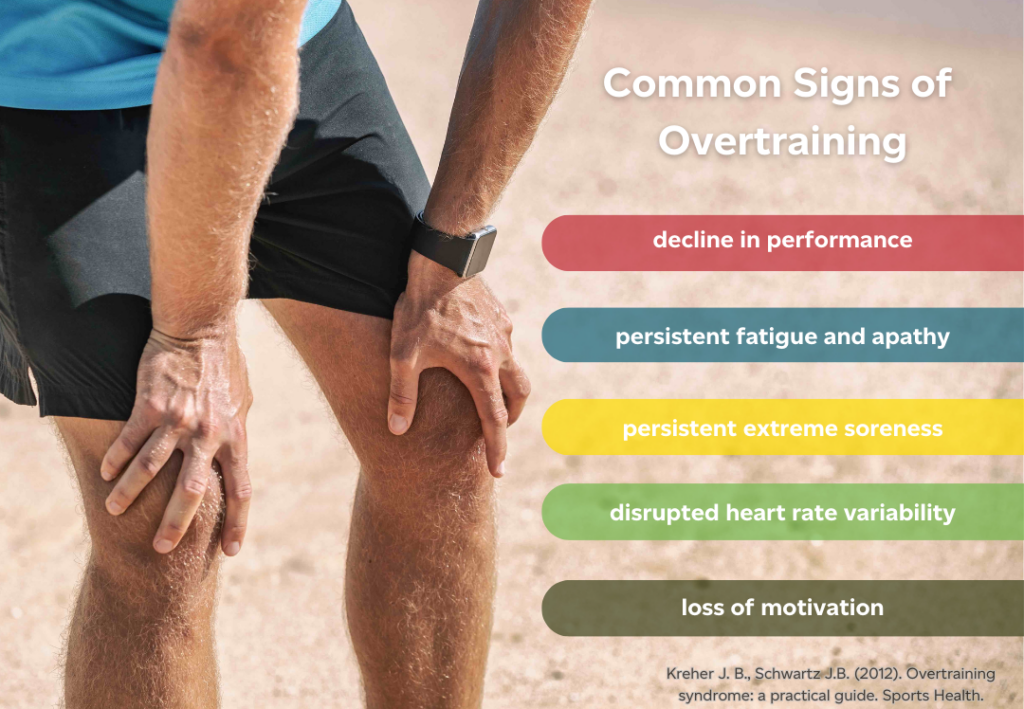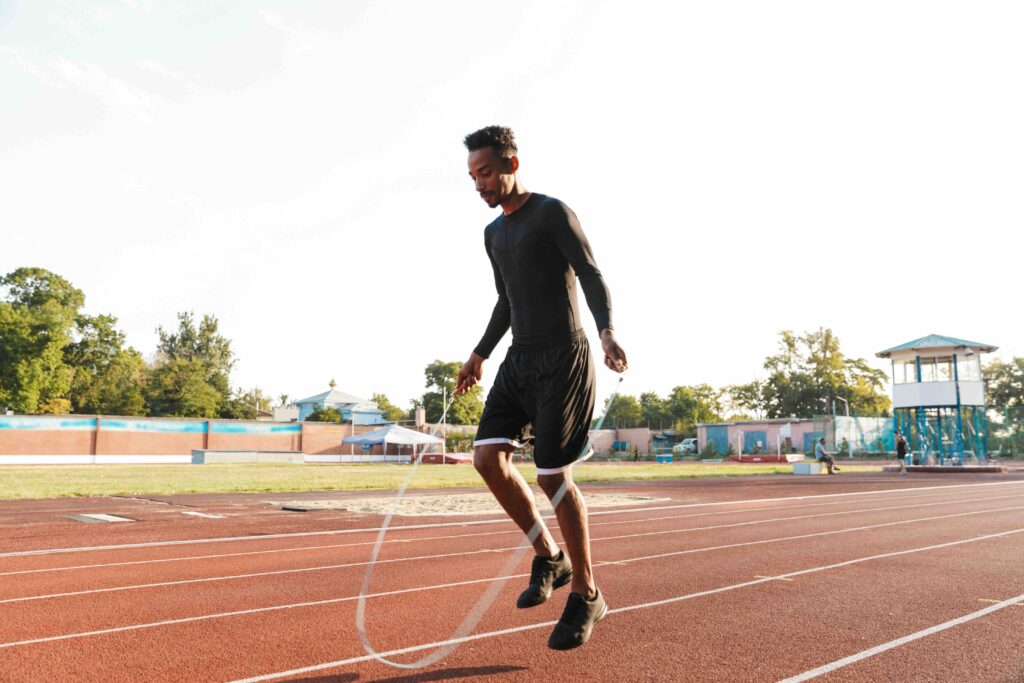

Does Heart Rate Variability Detect Overtraining?
In the realm of fitness and wearables, one metric has been gaining increasing attention for its potential insights into performance and recovery – heart rate variability (HRV). We chatted with Dr. Jeffrey Christle to demystify the nuances of HRV and its relationship with overtraining.
April 24, 2024

Jeffrey Christle, PhD
Dr. Jeffrey Christle is a clinical exercise physiologist at Stanford University. His expertise is in the areas of cardiopulmonary exercise testing, preventive and therapeutic exercise training, and cardiovascular health. His research focuses on the clinical applications of exercise testing and training, including the physiological evaluation of cardiovascular adaptation to exercise, monitoring physiological response using wearable devices, and the influence of exercise on patients with severe cardiovascular disease.
In the fitness world, we often hear about the idea of overtraining. People say, “Train hard!” But then they add a caveat – not too hard, or you might risk overtraining. It’s a bit confusing, isn’t it? How can you figure out the right amount of training?
Recently, the term heart rate variability (HRV) has been thrown into the mix as a metric for overtraining. Let’s take a closer look at the evidence behind HRV and clarify what we mean by overtraining.
What is Heart Rate Variability?
In simple terms, HRV is a measure of the difference in the time interval between consecutive heartbeats. While your wearable device might report your heart rate as 60 beats per minute (bpm), that doesn’t necessarily imply a uniform one-second gap between each heartbeat. The intervals between heartbeats can vary: one could occur after 1.3 seconds, followed by the next one happening 0.7 seconds later. The average time between beats is 1 second (so 60 beats in 1 minute), but the actual gap can fluctuate.
This is because heart rate variability is influenced by the balance between two branches of the nervous system: the parasympathetic branch (also known as the “rest and digest” processes) and the sympathetic branch (the so-called “fight or flight”).
A higher variability is generally associated with a more flexible and adaptable autonomic nervous system – the part of your body that controls involuntary functions like digestion and heart rate. This might seem counterintuitive, but a heart with high variability can respond more quickly to bodily demands compared to a tired and stressed organ.

YitzhakNat/Wikimedia Commons
HRV as a Metric for Overtraining
HRV has been leveraged for a variety of applications – from guiding the intensity of daily workouts to promoting overall wellness – but there is limited evidence for many of these. Of these, HRV is best used as a metric for the assessment of overtraining,1 said Dr. Jeffrey Christle.
The American College of Sports Medicine characterizes overtraining as a combination of training and non-training stress that causes a long-term decrease in performance capacity.2 It can also include physiological and psychological signs and symptoms of maladaptation, including fatigue, performance decline and mood disturbances. If a decline in performance persists for more than 3 to 4 weeks, it could indicate overtraining syndrome (OTS).2,3

What is overtraining?
Overtraining is what is known as a “diagnosis of exclusion,” meaning that it is what is left after other possible diagnoses are eliminated.2 Multiple body systems (hormonal, neurological, metabolic, psychological, etc.) have been identified as potentially diagnostic for overtraining but most likely it is combinations of these variables which would result in accurate diagnosis.
HRV serves as a flag of increased stress on the body, whether due to a large and sustained increased training load, illness, or other stressors.1 If your HRV takes a nosedive for 3 to 4 weeks, it could be a sign that you are overtraining, and fatigue could compromise your ability to respond effectively to more training.1,4 This decline in HRV becomes a cue for athletes to consider incorporating a rest period or lighter training days. Keep in mind that there are exceptions to this rule, and we’ll delve into those later.
Caution
A consistently low HRV compared to your baseline could also be a sign of stress, disease, anxiety or more. Consult with a doctor if you are worried.

Maridav/Adobe Free Images
Personalized Strategies to Measure HRV
Unlike measuring one’s heart rate during exercise, HRV is best measured when an individual is awake but not engaged in physical activity. Dr. Christle recommends establishing a baseline through consistent measurements. The gold standard of HRV monitoring is the use of electrocardiography (ECG), though chest straps and wristwatches are relatively accurate at rest.1
“Devices like a chest strap or a wristwatch are good to use as long as you’re not engaged in exercise during the measurement,”1 said Dr. Christle. “My personal recommendation is to measure your HRV in a fasted morning state. Don’t measure HRV when you’re asleep or during exercise; in both cases there is a large amount of variability. When you’re sleeping, there is transient parasympathetic activation that occurs when you transition between phases of sleep. When you exercise, your heart rate activity changes depending on your intensity levels.”1,5
Consistency is key. Even your body position matters. Your HRV differs depending on whether you are lying down, seated, or standing up. So measure your HRV in the same position. For an accurate measurement, the process should last for at least 5 minutes.1,6
“If you’re in a consistent state over time and your HRV number is getting larger,” said Dr. Christle, “that is a good sign there’s improvement in neurological heart rate control health.”
A large population range for HRV is approximately 20-200 milliseconds, which includes rest and activity, trained and untrained, according to Dr. Christle. A wearable-based compilation of HRVs across more than 8 million individuals found similar values, with values ranging from ~10ms to 130ms.5
That being said, heart rate variability is not about chasing a specific number; it’s about understanding how your nervous system responds and adapts over time. Dr. Christle emphasized the need to move beyond absolute numbers and focus on relative changes. There is variability day-by-day, but when graphed, for example, HRV would generally hover around your baseline value or appear as a gradual upward slope if you are increasing your exercise intensity (but not overtraining).
“There will be intermittent decreases and drops, which are completely normal,” said Dr. Christle. “After a hard day, you should expect your heart rate variability to come down. It’s a natural response to the stress you’ve imposed on your body.” By stressing your body, you have temporarily somewhat compromised its ability to respond optimally to external stressors and the HRV reflects that.

Training Tip
HRV is a personal metric, so it’s crucial to establish an individual baseline first. Find a consistent time of day to measure your HRV when you are in a fasted state, awake, and not exercising. After you wake up but before you eat breakfast is one good time.

Drobot Dean/Adobe Free Images
Other Factors That Influence HRV
It’s not just physical activity that stresses your body and affects heart rate variability. Lifestyle factors such as emotional stress, diet, alcohol consumption, smoking, and body composition also impact HRV.1
“In addition, there’s some genetic component that we don’t know about yet,” said Dr. Christle. “So it would be irresponsible of me to say that this is all nurture and no nature.”7
Sleep is also an important factor that influences HRV and overall recovery.1 Adequate sleep is crucial for enabling the body to recover and prepare for subsequent training sessions.
So if your HRV does take a dive for several weeks, be sure to consider other factors that may be the culprit aside from just overtraining.

leungchopan/Adobe Free Images

I’m a powerlifter. How does HRV apply to me?
There is scarcity of data on resistance training and powerlifting, acknowledged Dr. Christle. The existing literature leans towards aerobic or endurance sports such as runners, swimmers, cyclists, and skiers, leaving a gap in our understanding of HRV in the context of resistance and power training.
HRV has emerged as a potentially useful tool to monitor overtraining in the age of wearable technology and personal lifestyle modifications. Yet, there is still a need to explore its full potential, including the possibility of HRV-guided training that designs personalized daily fitness programs based on HRV metrics.8,9,10
Get Deeply Researched Insights on Human Performance
Join our mailing list to get actionable performance tips and nuanced explanations of the science.

Flash Q&A with Dr. Jeffrey Christle
What activities do you enjoy to stay active?
I’m an avid soccer player. I’ve played soccer since I was four years old. I play in a competitive 11-on-11 league, and as I have gotten older I have adapted my game from an offensive to a defensive field position. I’ve played tennis since I was in high school. I’m a runner and a cyclist. I probably run about 30 miles and cycle about 45-50 miles every week. I also love to go climbing, ice skating, rollerblading, hiking, pretty much anything outdoors. My wife and 3 daughters (11, 9 and 5) join in for most of these activities when they can.
What are you most excited about in the field right now?
I think we’re starting to enter a new age in exercise where the pleasure of the experience and the holistic part of exercise is becoming reintegrated into the concept of performance. There are some excellent athletes who probably don’t have very high VO2 max, but they enjoy what they’re doing and they’re good at it. I think the inclusivity is probably what I’m excited about in the next 10, 20 years, because in the past a lot of people have been left out from athletics, and there’s no reason for that at all; everyone should feel welcome.
Citations
- Lundstrom C. J., Foreman N. A., Blitz G. (2023). Practices and applications of heart rate variability monitoring in endurance athletes. International Journal of Sports Medicine. 44(01): 9-19. https://doi.org/10.1055/a-1864-9726
- Carrard J., Riggort A., Appenzeller-Herzog C., et al. (2022). Diagnosing overtraining syndrome: a scoping review. Sports Health. 14(5): 665–673. https://doi.org/10.1177/19417381211044739
- Kreher J. B., Schwartz J.B. (2012). Overtraining syndrome: a practical guide. Sports Health. 4(2):128-38. https://doi: 10.1177/1941738111434406.

Are these findings about overtraining syndrome in Carrard, J., et al. (citation 3) equally true for male and female athletes?
The findings are more likely to hold true for males since female athletes are underrepresented in these research studies.
- Singh N., Moneghetti K. J., Christle J. W., et al. (2018). Heart rate variability: an old metric with new meaning in the era of using mHealth technologies for health and exercise training guidance. Part two: prognosis and training. Arrhythmia and Electrophysiology Review. 7(4):247-255. https://doi.org/10.15420/aer.2018.30.2
- Natarajan, A., Pantelopoulos A., Emir-Farinas H., et al. (2020). Heart rate variability with photoplethysmography in 8 million individuals: a cross-sectional study. The Lancet – Digital Health. 2(12): E650-E657. https://doi.org/10.1016/S2589-7500(20)30246-6
- Boudreau P., Yeh WH., Dumont., et al. (2013). Circadian variation of heart rate variability across sleep stages. Sleep. 36(12): 1919–1928. https://doi.org/10.5665/sleep.3230
- Golosheykin S., Grant J. D., Novak O. G., et al. (2018). Genetic influences on heart rate variability. International Journal of Psychophysiology. 115: 65–73. https://doi.org/10.1016/j.ijpsycho.2016.04.008
- Manresa-Rocamora A., Sarabia J. M., Javaloyes A., et al. (2021). Heart rate variability-guided training for enhancing cardiac-vagal modulation, aerobic fitness, and endurance performance: a methodological systematic review with meta-analysis. 18(19): 10299. https://doi.org/10.3390/ijerph181910299
- Düking P., Zinner C., Trabelsi K., et al. (2021). Monitoring and adapting endurance training on the basis of heart rate variability monitored by wearable technologies: A systematic review with meta-analysis. Journal of Science and Medicine in Sport. 24(11): 1180-1192. https://doi.org/10.1016/j.jsams.2021.04.012
- Bourdillon N., Schmitt L., Yazdani S., et al. (2017). Minimal window duration for accurate HRV recording in athletes. Frontiers in Neuroscience. 11. https://doi.org/10.3389/fnins.2017.00456
Playbook Terms of Use & Copyright
©2023-2024



